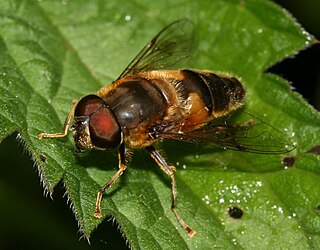
Eristalis pertinax is a hoverfly in the family Syrphidae. It was first described by Giovanni Antonio Scopoli in 1763 and is found in Asia and Europe. Like Eristalis tenax, the larvae of E. pertinax are rat-tailed maggots living in drainage ditches, pools around manure piles, sewage, and similar places containing water with high organic load and low oxygen concentration.

Syrphus ribesii is a very common Holarctic species of hoverfly. Its larvae feed on aphids. In common with many other species of hoverfly, males have the eyes meeting on the top of the head, whilst females have their eyes widely separated.

Eristalinus is a genus of hoverfly. Most species have very distinctive eye marking in the form of spots or banding, though these features may fade on some preserved specimens. Most are stout flies, and are nimble flyers, even compared to other hoverfly species.

Spilomyia sayi, the Four-lined Hornet Fly, is a fairly common species of syrphid fly. This species is found from western Canada to northeastern North America. Hoverflies get their names from the ability to remain nearly motionless while in flight. The adults are also known as flower flies for they are commonly found around and on flowers, from which they get both energy-giving nectar and protein-rich pollen. The larvae are known as the short-tailed larvae, suited for moist areas such as rot holes of trees. It is a wasp mimic.
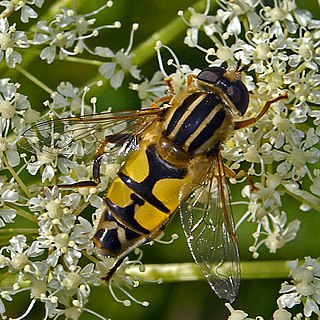
Helophilus trivittatus is a species of Palearctic hoverfly.
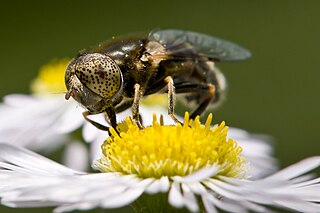
Eristalinus aeneus, the common lagoon fly, is a fairly common species of syrphid fly observed throughout the United States and Europe. Hoverflies can remain nearly motionless in flight. The adults are also known as flower flies for they are commonly found on flowers, from which they get both energy-giving nectar and protein-rich pollen. The larvae occurs along shorelines in rock pools containing large amounts of decaying seaweed.
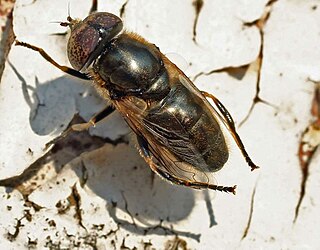
Eristalinus sepulchralis is a European species of hoverfly. The species are brownish-white from a close up, and look like a wasp. From a distance though, they are yellowish-black coloured, and look like a bumble bee. The species can be found throughout Europe in the Baltic states, North Europe, Central, Southern and Western Europe and across the Palaearctic to Kamchatka, Japan, China and India. Finland, Great Britain, Hungary, Ireland, Norway, and the Netherlands.
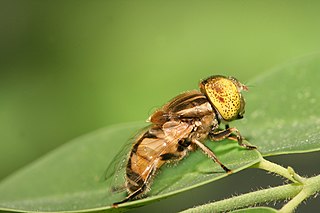
Eristalinus megacephalus is a species of hoverfly.
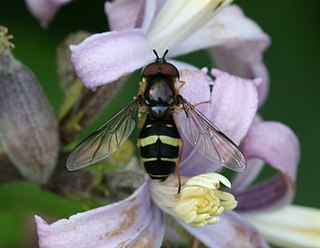
Dasysyrphus tricinctus is a European species of hoverfly in the genus Dasysyrphus, a member of the family Syrphidae. It is found across Europe, although reported in highest density from the British Isles and Scandinavia. While not uncommon it is generally only seen in modest numbers, typically in lowland woods with peak numbers in late May and early June and again in late August and early September.

Leucozona lucorum is a Palearctic and Nearctic species of hoverfly.
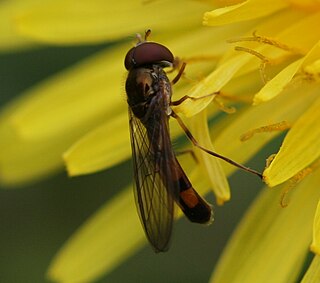
Melanostoma scalare, the chequered hoverfly, is a very common species of hoverfly.

Baccha elongata is a species of hoverfly in the genus Baccha.
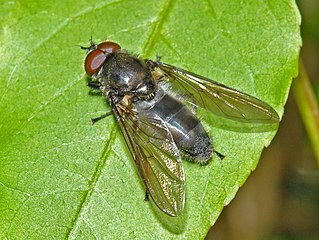
Cheilosia variabilis, common name figwort cheilosia, is a species of hoverfly belonging to the family Syrphidae.

Eriozona syrphoides is a European species of hoverfly. A large bee mimic. The thorax has black hairs in the middle and yellow or reddish hairs on the front and hind margins. The scutellum is white to yellow with yellow hairs. The abdomen has white hairs in front, black in the middle and has red hairs at the tip. The wing has a dark patch. The habitat is Picea, Abies forest. It is arboreal descending to feed on white umbellifers, Centaurea, Cirsium, Crataegus, Epilobium, Hypericum, Ranunculus, Sambucus nigra, Sorbus aucuparia, Succisa, Valeriana. It ranges from Fennoscandia south to France and from Ireland eastwards through Central Europe and northern Italy into European Russia and the Russian Far East and on through Siberia to the Pacific coast. The larva feeds on aphids.

Syrphus torvus, the Hairy-eyed Flower Fly, is a common species of hoverfly found in the Holarctic. The adults feed on pollen and nectar, but the larvae feed on aphids.

Paragus haemorrhous, the Black-backed Grass Skimmer is a common widespread species of hoverfly found in many parts of Europe, Africa and the Nearctic. Hoverflies can remain nearly motionless in flight. The adults are also known as flower flies for they are commonly found on flowers from which they get both energy-giving nectar and protein-rich pollen. The larvae are predators on aphids.

Cheilosia impressa is a Palearctic species of hoverfly. Like most members of its genus C. impressa is a rather small, dark insect and identification can be problematic.
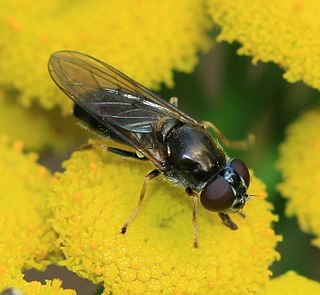
Cheilosia scutellata is a Palearctic hoverfly.

Mallota cimbiciformis is a Palearctic hoverfly.

Mesembrina mystacea is a fly belonging to the family Muscidae.




























